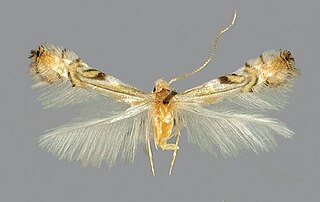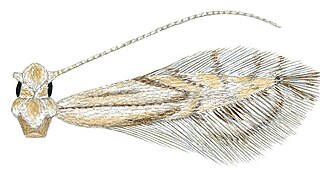| Phyllocnistis perseafolia | |
|---|---|
 | |
| Scientific classification | |
| Kingdom: | |
| Phylum: | |
| Class: | |
| Order: | |
| Infraorder: | |
| Family: | |
| Genus: | |
| Species: | P. perseafolia |
| Binomial name | |
| Phyllocnistis perseafolia Davis and Wagner, 2011 [1] | |
Phyllocnistis perseafolia is a moth of the family Gracillariidae. It is known only from the type locality in the Department of Caldas, west-central Colombia, but probably widespread over northern South America wherever avocado is cultivated.

Moths comprise a group of insects related to butterflies, belonging to the order Lepidoptera. Most lepidopterans are moths, and there are thought to be approximately 160,000 species of moth, many of which have yet to be described. Most species of moth are nocturnal, but there are also crepuscular and diurnal species.

Gracillariidae is an important family of insects in the order Lepidoptera and the principal family of leaf miners that includes several economic, horticultural or recently invasive pest species such as the horse-chestnut leaf miner, Cameraria ohridella.

Colombia, officially the Republic of Colombia, is a sovereign state largely situated in the northwest of South America, with territories in Central America. Colombia shares a border to the northwest with Panama, to the east with Venezuela and Brazil and to the south with Ecuador and Peru. It shares its maritime limits with Costa Rica, Nicaragua, Honduras, Jamaica, Haiti, and the Dominican Republic. Colombia is a unitary, constitutional republic comprising thirty-two departments, with the capital in Bogotá.



The length of the forewings is 2.6–3.2 mm. Adults have been recorded in April in Colombia.
The larvae feed on Persea americana . Serpentine mines of possibly this species have also been observed on avocado fruit. They mine the leaves of their host plant. The mine has the form of a long, slender, serpentine gallery, containing a dark, narrow, median frass trail, present on either the underside or upperside of the leaf, with pupation occurring in a slightly enlarged, elliptical chamber at the mine terminus along the leaf edge.

A leaf miner is the larva of an insect that lives in and eats the leaf tissue of plants. The vast majority of leaf-mining insects are moths (Lepidoptera), sawflies and flies (Diptera), though some beetles also exhibit this behavior.
Frass refers loosely to the more or less solid excreta of insects, and to certain other related matter.






